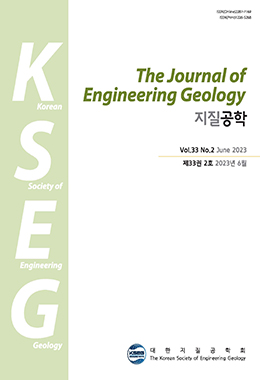지구온난화로 인해 극지방에 대한 접근성이 높아짐에 따라 석유자원이 풍부한 영구동토 지역에서 자원개발 플랜트 건설의 수요가 증가하고 있다. 동토 지역에서의 자원개발 플랜트 건설 입지는 동토 활성층의 융해와 동결에 기인하는 지표변위가 필수적으로 고려되어야 한다. 그러나 동토의 변위를 고려하여 자원개발 플랜트 건설의 입지를 선정한 연구 사례는 거의 없다. 이 연구에서는 캐나다 앨버타 주의 Athabasca 남부 지역에서 최적의 오일샌드 개발 플랜트 건설 입지를 선정하기 위해 지표변위를 비롯한 다양한 공간정보를 활용하여 계층화 분석(Analytical Hierarchy Process)을 수행하였고, 동토 지역에서의 자원개발 플랜트 건설 활동에 있어 지표변위의 중요성을 논의하였다. 2007년 2월부터 2011년 3월까지 획득된 시계열 ALOS PALSAR 영상에 Small BAseline Subset-Interferometric Synthetic Aperture Radar 기법을 적용하여 지표변위 속도 정보를 구축하였고, ERA5 재분석 자료로부터 2000~2010년 기간에 대한 평균 기온, 지표온도, 지중온도 정보를 구축하였다. 도로 및 철도와 토지피복 공간정보는 각각 캐나다 연방 통계청과 북미환경협력위원회에서 제공하는 자료를 구축하여 활용하였다. 토지피복, 지표변위, 도로 접근성을 가장 중요한 공간정보로 설정하여 수행한 최적 입지 분석 결과는 2010년 이후 건설된 오일샌드 플랜트 건설지와 비교하여 그 타당성이 확인되었고, 입지 적합도 평가에 대한 지표변위의 민감도는 매우 높은 것으로 분석되었다. 이 연구를 통하여 동토 지역에 서 최적의 자원개발 플랜트 건설지를 선정하는데 지표변위가 필수적으로 고려되어야 함이 확인되었다
Global warming has made the polar regions more accessible, leading to increased demand for the construction of new resource-development plants in oil-rich permafrost regions. The selection of locations of resource-development plants in permafrost regions should consider the surface displacement resulting from thawing and freezing of the active layer of permafrost. However, few studies have considered surface displacement in the selection of optimal locations of resource-development plants in permafrost region. In this study, Analytic Hierarchy Process (AHP) analysis using a range of geospatial information variables was performed to select optimal locations for the construction of oilsands development plants in the permafrost region of southern Athabasca, Alberta, Canada, including consideration of surface displacement. The surface displacement velocity was estimated by applying the Small BAseline Subset Interferometric Synthetic Aperture Radar technique to time-series Advanced Land Observing Satellite Phased Array L-band Synthetic Aperture Radar images acquired from February 2007 to March 2011. ERA5 reanalysis data were used to generate geospatial data for air temperature, surface temperature, and soil temperature averaged for the period 2000~2010. Geospatial data for roads and railways provided by Statistics Canada and land cover maps distributed by the North American Commission for Environmental Cooperation were also used in the AHP analysis. The suitability of sites analyzed using land cover, surface displacement, and road accessibility as the three most important geospatial factors was validated using the locations of oil-sand plants built since 2010. The sensitivity of surface displacement to the determination of location suitability was found to be very high. We confirm that surface displacement should be considered in the selection of optimal locations for the construction of new resource-development plants in permafrost regions.




